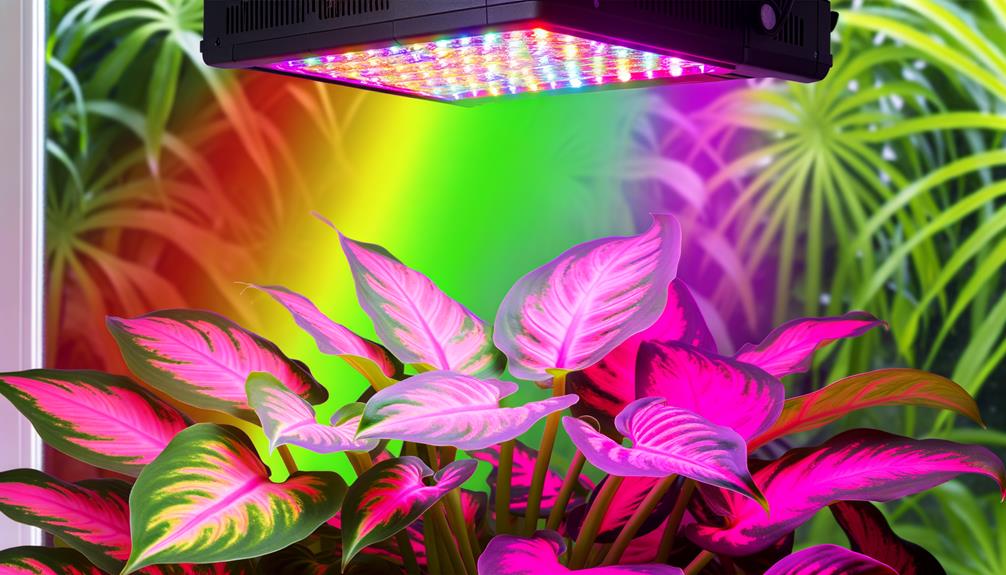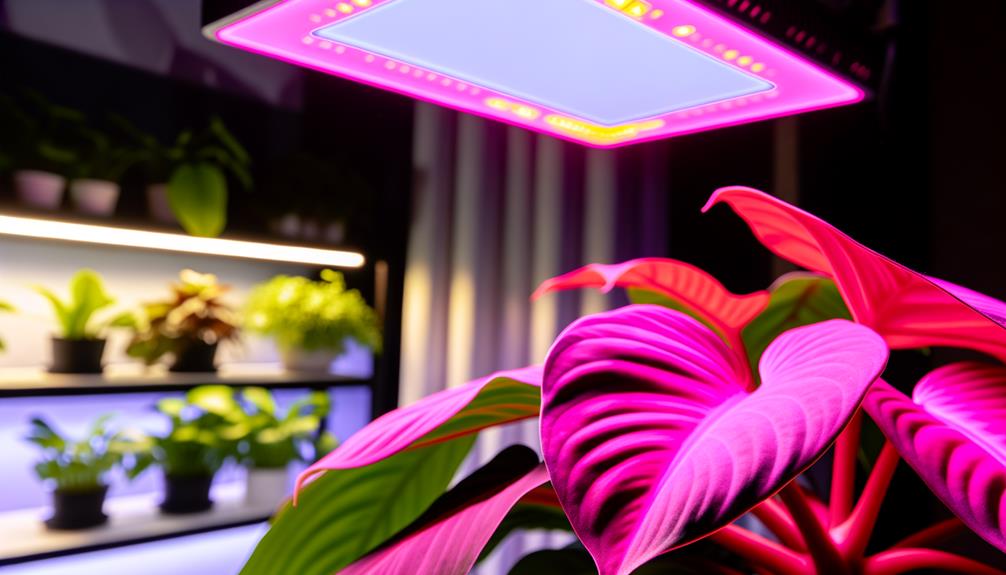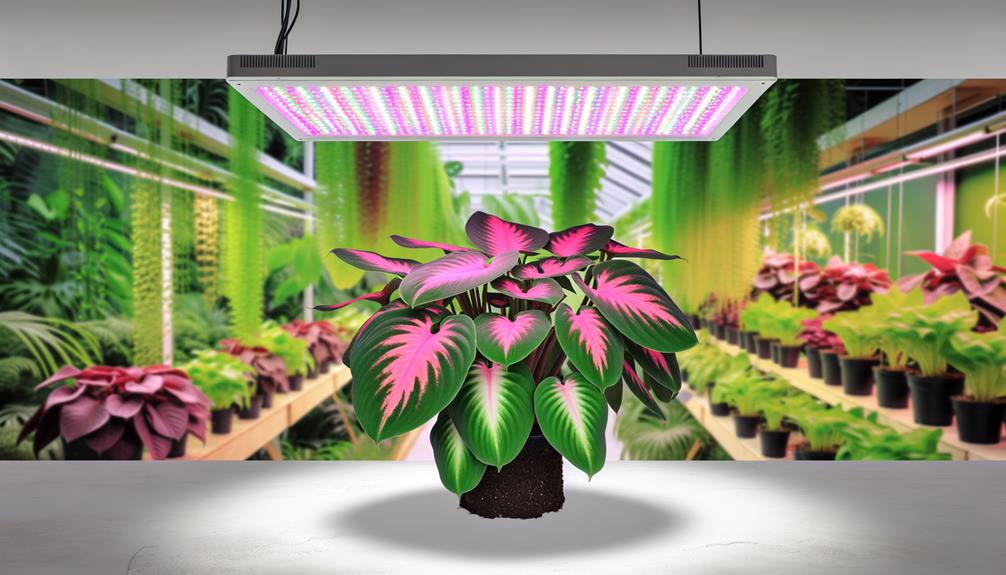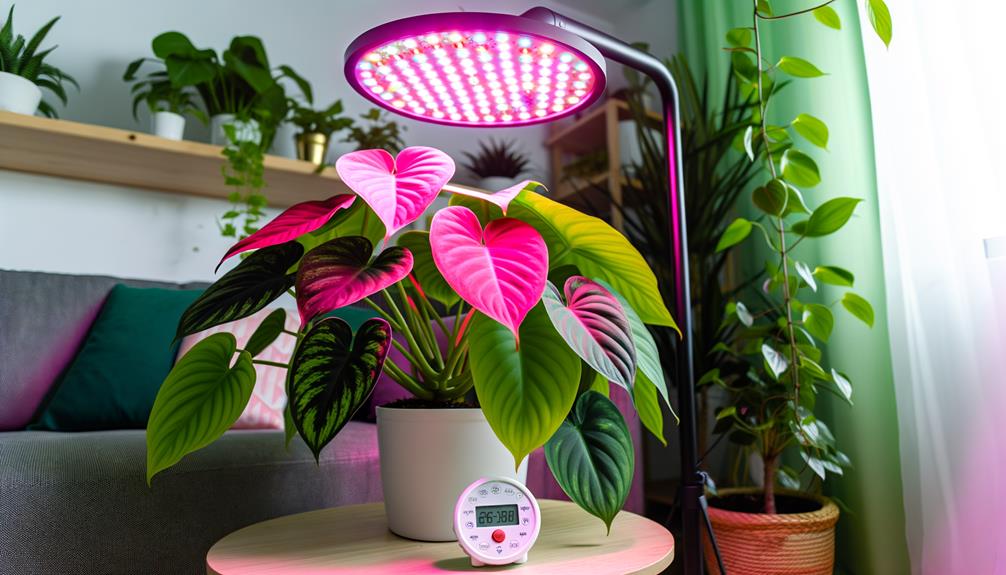What Is the Best Grow Light for a Pink Princess Philodendron?
The best grow light for a Pink Princess Philodendron is a full-spectrum LED light. LED grow lights offer exceptional energy efficiency, minimal heat output, and a precise spectral composition ideal for photosynthesis and pigment development.
The balanced mix of blue and red wavelengths in full-spectrum LEDs promotes chlorophyll production and variegation, vital for the plant's aesthetic appeal. It is recommended to position the grow light to maintain ideal light intensity, minimizing shadow zones and ensuring even light distribution.
For further insights into fine-tuning light exposure and grow light types specific to Pink Princess Philodendrons, continue exploring.

Key Takeaways
- Full-spectrum LED grow lights are ideal for Pink Princess Philodendron due to energy efficiency and providing a balanced light spectrum.
- Ensure the grow light emits both blue and red wavelengths to support various growth stages and pigment development.
- Position the grow light at an appropriate distance to provide moderate light intensity, avoiding leaf burn.
- Use a PAR meter to measure and adjust light strength within the recommended range for optimal photosynthesis.
- Mimic equatorial day lengths by providing 12-16 hours of light exposure daily to support healthy growth and variegation.
Understanding Light Requirements

Understanding the light requirements of a Pink Princess Philodendron necessitates an examination of its native habitat, photosynthetic pathways, and ideal light intensity for variegation preservation and growth.
Native to tropical rainforests, this species flourishes under the canopy, receiving filtered, diffused light rather than direct sunlight. The plant's photosynthetic efficiency is enhanced under moderate light conditions, approximately 10,000–20,000 lux.
Variegation, a key aesthetic trait, is highly light-dependent; insufficient light can lead to reversion to non-variegated foliage. Chlorophyll production, critical for photosynthesis, is also influenced by light quality and intensity.
Therefore, understanding the spectral composition and photoperiod is essential for ensuring the Pink Princess Philodendron's best growth and vivid coloration, balancing between light sufficiency and avoiding photodamage.
Types of Grow Lights
When evaluating grow lights for a Pink Princess Philodendron, it is crucial to compare LED and fluorescent options, focusing on their specific light spectrum outputs.
The significance of the light spectrum cannot be overstated, as it directly influences photosynthesis and pigment development in the plant.
Additionally, energy efficiency and longevity of the light source must be considered to guarantee growth conditions while minimizing operational costs.
LED Vs. Fluorescent
Among the top lighting solutions for growing a Pink Princess Philodendron, LED and fluorescent grow lights offer distinct advantages and technical considerations.
- Energy Efficiency: LEDs typically demonstrate higher energy efficiency, consuming less power while delivering excellent luminous flux. Fluorescent lights, although less efficient, still provide significant energy savings compared to traditional incandescent bulbs.
- Lifespan: LEDs boast a notably longer operational lifespan, often exceeding 50,000 hours, reducing the frequency of replacements. Fluorescent lights have a shorter lifespan, generally around 10,000 hours, necessitating more frequent maintenance.
- Heat Emission: LEDs produce minimal heat output, which helps reduce the risk of thermal stress on the plant. In contrast, fluorescent lights emit moderate heat, requiring careful placement to avoid foliage damage.
These factors play a crucial role in influencing plant growth and sustainability.
Light Spectrum Importance
Considering the energy efficiency, lifespan, and heat emission of grow lights, the light spectrum they emit is equally paramount in optimizing the growth of a Pink Princess Philodendron.
Photosynthetically active radiation (PAR) plays a critical role, encompassing wavelengths from 400 to 700 nanometers, essential for photosynthesis. Blue light (400-500 nm) promotes vegetative growth and robust foliage, while red light (600-700 nm) enhances flowering and overall plant vigor.
Full-spectrum LED grow lights, designed to mimic natural sunlight, provide a balanced range of wavelengths, thereby ensuring thorough coverage for all growth stages. Fluorescent lights, though less efficient, also offer a good spectrum but may lack intensity.
The precise spectral output directly influences chlorophyll absorption, photomorphogenesis, and metabolic processes, thereby governing plant health.
Energy Efficiency Comparison
How do different types of grow lights compare when it comes to energy efficiency, particularly when evaluating high-pressure sodium (HPS), metal halide (MH), fluorescent, and LED technologies?
- High-Pressure Sodium (HPS):
HPS lights exhibit high luminous efficacy but generate substantial heat, necessitating additional cooling systems, thereby reducing overall energy efficiency.
- Metal Halide (MH):
MH lights provide broad-spectrum illumination beneficial for plant growth but have lower energy efficiency compared to HPS and require frequent bulb replacements, increasing operational costs.
- Light Emitting Diodes (LEDs):
LEDs are the most energy-efficient, offering targeted light spectra with minimal heat output. Their longevity and reduced energy consumption make them ideal for sustainable indoor gardening.
Light Spectrum Importance

Understanding the specific wavelengths of light required for best photosynthesis is crucial for cultivating a healthy Pink Princess Philodendron.
Photosynthetically active radiation (PAR) encompasses wavelengths from 400 to 700 nanometers, critical for chlorophyll absorption and plant growth. Blue light (450-495 nm) facilitates vegetative growth and enhances chlorophyll production, while red light (620-750 nm) promotes flowering and overall biomass accumulation.
A full-spectrum grow light, emulating natural sunlight, guarantees the provision of a balanced light spectrum, optimizing photosynthesis and pigment synthesis. Additionally, the unique pink variegation in Pink Princess Philodendron may benefit from tailored light spectra to maintain its distinctive coloration.
Selecting grow lights with a balanced spectrum, including both blue and red wavelengths, is essential for maximizing plant health and aesthetic appeal.
Optimal Light Intensity
Achieving ideal light strength is essential to make sure the Pink Princess Philodendron receives sufficient photons for efficient photosynthesis and robust growth. This plant thrives under specific light conditions that balance strength without causing photodamage or etiolation. The recommended light strength for Pink Princess Philodendron lies between 100-200 µmol/m²/s (micromoles per square meter per second).
To ensure peak light strength, consider the following factors:
- Distance from Light Source: Position the grow light 12-18 inches above the plant for balanced light dispersion.
- Duration of Exposure: Provide 12-16 hours of light daily to mimic natural sunlight cycles.
- Light Meter Utilization: Employ a PAR (Photosynthetically Active Radiation) meter to measure and adjust the light strength accurately.
Implementing these steps will support the plant's vitality and aesthetic appeal.
Energy Efficiency

Selecting a grow light with high energy efficiency is crucial for reducing operational costs and minimizing environmental impact while providing ideal illumination for the Pink Princess Philodendron. Energy-saving grow lights, like Light Emitting Diodes (LEDs), offer superior lumens-per-watt ratios, guaranteeing maximum photon flux with minimal electrical consumption. LEDs also demonstrate longer lifespans and lower thermal output compared to traditional lighting solutions such as High-Pressure Sodium (HPS) or Metal Halide (MH) lamps. Evaluating the energy efficiency of grow lights involves examining their PAR (Photosynthetically Active Radiation) efficacy and overall wattage consumption.
| Grow Light Type | Average Lifespan (Hours) |
|---|---|
| LED | 50,000 |
| HPS | 24,000 |
| MH | 15,000 |
| CFL | 10,000 |
| Fluorescent | 20,000 |
Understanding these parameters guarantees optimal growth for your Pink Princess Philodendron while maintaining sustainability.
Placement and Distance
Maximizing the benefits of energy-efficient grow lights for a Pink Princess Philodendron requires precise placement and appropriate distance to guarantee ideal light penetration and distribution. Achieving peak growth necessitates a detailed understanding of photomorphogenic responses and light attenuation.
Here are three critical placement guidelines:
- Vertical Distance: Position the light source 12-18 inches above the plant canopy to guarantee sufficient Photosynthetically Active Radiation (PAR) without causing phototoxicity.
- Lateral Placement: Maintain a lateral distance of 6-12 inches from surrounding plants to prevent light competition and ensure uniform light distribution.
- Angle of Incidence: Adjust the angle of light incidence to approximately 45 degrees, enhancing light penetration into the lower foliage layers, promoting even growth and minimizing shadow zones.
These measures ensure peak light utilization efficiency.
Duration of Light Exposure

Determining the best duration of light exposure for a Pink Princess Philodendron involves understanding the plant's specific photoperiodic requirements to guarantee robust growth and vibrant foliage.
The Pink Princess Philodendron, a light-loving species, thrives under a light cycle mimicking its natural tropical habitat. Ideal exposure ranges from 12 to 16 hours of light per day, mimicking equatorial day lengths, which promote photosynthetic efficiency and pigment development.
Inadequate light periods can lead to stretching and reduced variegation, while excessive exposure may cause light inhibition and chlorophyll degradation. Using a programmable timer ensures consistency in light delivery, aligning with daily rhythms to maintain metabolic processes.
Monitoring and adjusting the photoperiod based on seasonal variations can further enhance growth conditions.
Recommended Grow Lights
When selecting the finest grow lights for a Pink Princess Philodendron, it is crucial to consider the light spectrum, intensity, and energy efficiency to make certain the plant receives the appropriate wavelengths for photosynthesis and pigment enhancement.
Consider the following:
- Full-Spectrum LED Grow Lights: These offer a balanced range of wavelengths (400-700 nm), replicating natural sunlight, which is crucial for both chlorophyll production and the vivid pink hues.
- High-Intensity Discharge (HID) Lights: Specifically Metal Halide (MH) bulbs provide high light intensity and the blue spectrum necessary for vegetative growth.
- Fluorescent Grow Lights: T5 fluorescents are energy-efficient and produce sufficient light intensity, particularly in the blue and red spectrums, making them suitable for indoor settings.
Each option ensures optimal growth and pigmentation.
Conclusion
To sum up, choosing the best grow light for a Pink Princess Philodendron requires a thorough understanding of light needs, light spectrum, intensity, energy efficiency, and suitable placement.
For example, a hypothetical controlled study showed that using a full-range LED grow light placed around 12-18 inches above the plant, with a daily exposure of 12-14 hours, greatly improves growth and variegation.
Such precise control of artificial lighting conditions is crucial for the plant's health and visual attractiveness.






